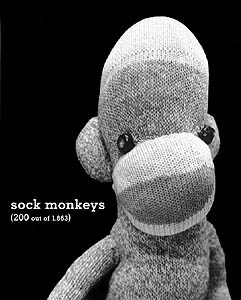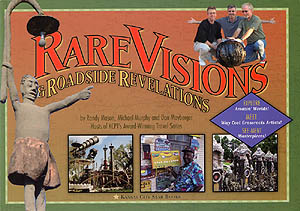|
Popular expressions
 Sock Monkeys (200 out of 1,863)
Sock Monkeys (200 out of 1,863)
By Arne Svenson and Ron Warren, Ideal World Books, 224 pages, 2 color and 200 black-and-white images, 2003, ISBN 0-9722111-2-8
Rare Visions & Roadside Revelations
By Randy Mason, Michael Murphy and Don Mayberger, Kansas City Star Books, many color and black-and-white pictures, 192 pages, 2002, ISBN 0-9712920-2-7
It was arguably David Letterman who brought sock monkeys out of their flea market and thrift store ghetto to become staples of crafts stores, Ebay auctions and hip collectible shops. The year he hosted the Academy Awards, Letterman showed a clip from the Chris Elliott movie Cabin Boy that featured himself and a barrel of the unassuming stuffed toys. For younger people it was an introduction to an uncommercial kind of plaything, and for older folks a reminder of something many had played with or at least seen in their youth.
Traditionally handmade and anonymous, sock monkeys thanks to Dave are now mass-produced novelty items and easier to find than the Rockford Red Heel Socks from which they're made. These new commodity dolls also have made the older one-offs not only more desirable as collectibles, but that much more charming in their individuality.
Sock Monkeys (200 out of 1,863) makes an eloquent case for just how expressive a popular craft can be, while also demonstrating the dimension that a professional photographer can bring to an art object.
Built around the collection of Ron Warren and the studio photography of Arne Svenson, the book devotes a full-page black-and-white image to each of 200 monkeys. The portraiture, made all the more intriguing by its unlikely subject matter, captures a primitive individualism in each doll, beyond what ordinarily comes across in person. The variability is striking even if you're thoroughly familiar with the genre.
The personality invested in the monkeys is strong enough to almost justify the fictional biographies that constitute the book's primary conceit and most of its text. It appears someone did not think that sock monkeys alone could carry a project of this magnitude. Unfortunately, the various authors brought in to help, including the usually entertaining Penn and Teller, can't pull it off something this forced. The text vignettes, supposedly inspired by particular dolls, seem arbitrary, relating to some bright idea that has little or nothing to do with the monkeys.
Fortunately, the photos speak for themselves. They reveal wonderful nuances of texture, expressive eyes and mouths, imaginative clothes, oddball shapes and, in most cases, the engaging patina of a doll that has been played. Of most interest to Intuit readers, these details express well the personal solutions that crafters took to the modest but necessarily creative challenges of putting together bodies and faces from equally modest materials. Those solutions constitute a great example of art whose creators would never call it that.
 The authors of Rare Visions and Roadside Revelations have jobs many of us would give our eyeteeth for: Scout out the identity and location of interesting folk and eccentric artists, throw in some interesting tourist traps, go visit them and make a TV show out of your trips.
The authors of Rare Visions and Roadside Revelations have jobs many of us would give our eyeteeth for: Scout out the identity and location of interesting folk and eccentric artists, throw in some interesting tourist traps, go visit them and make a TV show out of your trips.
The authors have been visiting artists and sites since 1995, and have scores of notches on their minivan. They started out in the vicinity of Kansas City, where they work as producers for public TV station KCPT, but have since extended their scope to include most of the Midwest and beyond to keep their program supplied with a steady flow of new material.
That mandate has made the trio omnivorous in their pursuit of art. As a result scholarly connoisseurship is not their strong suit, as they themselves admit. Instead, like sensible collectors everywhere, they mostly look for what strikes their fancy rather than for what is necessarily considered important, though the two often are the same. In any event, the selections on the show, and to a lesser extent in this book, tend toward the uncritical. Their casual approach also means they sometimes hit the road in search of the next attraction just when things start getting interesting -- the most serious criticism I can make of their efforts.
But the flip side of their profligacy is that Rare Visions, the show and the book, is one of the most comprehensive guides available to environments and folk-art-related attractions in the Midwest, covering any number of people and places that are missing from the more scholarly tomes. Their approach also inherently makes a case for the resonant connections between roadside environments and more traditional roadside attractions. And it means that if you're not especially interested in the artist they are currently profiling, you don't have to wait long for them to get to one that you do care about. (Among others, these include, for me, D. Bill, the pole carver of Bloomington, IL; M.T. Liggett, the topical sculptor of Mullinville, KS; and Ralph Lanning, the environmental sculptor of Republic, MO.)
The upshot is that Rare Visions is one of the most interesting and entertaining half hours on public TV, especially considering that it is reaching people who would never crack those weightier and undoubtedly important art resources.
Though Rare Visions the book covers only a portion of the places the authors have gone on the show, it still features a good sample -- as well as a bit of the corniness that causes some viewers to lose patience. If you buy the guys as TV personalities, though, the shtick that makes it into the book fits in reasonably well with the basic road-trip premise. (Anyway, I like Don the Camera Guy, even if the games of catch are a bit dubious.)
In the interests of full disclosure, I contributed a handful of photos to the book, and my Web site receives a recommendation, as does Intuit's. But log rolling aside, for the art-oriented traveler this is as good a Midwest-oriented guidebook as any of those weird, wacky America volumes, and its generous, non-academic take on artists and environments constitutes a refreshing supplement to the more straight-faced approach favored by self-taught art coffee table books. Straight-faced, not scholarly, is the right word, since many of those books are no better informed, despite their pretensions, than this one.
For those who can't watch the show in Kansas City Public Television, you can order tapes at http://www.kcpt.org/rare_visions/tapes.html. The site currently lists 16 volumes, with two half-hour episodes per tape.
|